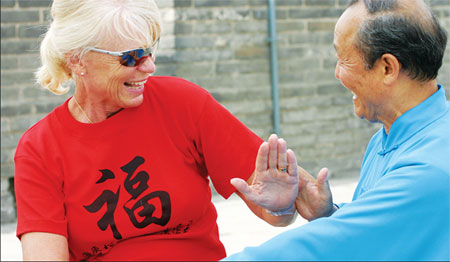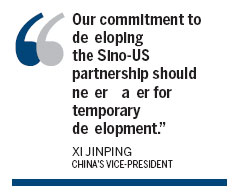Face-to-face diplomacy
Updated: 2012-02-13 11:31
By Tan Yingzi and Cheng Guangjin (China Daily)
|
||||||||
|
A visitor from the United States learns tai chi from 76-year-old Zhang Tuo on the ancient city wall of Xi'an, Shaanxi province. [Wei Yongxian / for China Daily] |
|
|
Even in difficult times, Chinese and US leaders remain strongly committed to open communication, Tan Yingzi and Cheng Guangjin report from Washington and Beijing.
The coming visit of Chinese Vice-President Xi Jinping is expected to provide an opportunity to further promote public diplomacy between the two countries.
Xi is visiting the United States at the invitation of Vice-President Joe Biden, starting from Feb 13 to 17.
"I hope that my visit can play a positive role in advancing the Sino-US partnership," Xi said from Beijing prior to his visit to the US.
During his visit, aside from Biden, Xi will meet President Barack Obama on Feb 14. He is also scheduled to visit Iowa, where he will visit the American families that hosted him during his visit in 1985. On Feb 16, he will deliver a speech to the local business community in Los Angeles.
"It is a very good thing," David Lampton, director of the China Studies Program at Johns Hopkins University in Baltimore, told China Daily. "He will be welcomed."
Lampton, a veteran China hand, said it is important that the new generation of Chinese leaders have good personal knowledge of their American counterparts, so that when they work together in the future they can have a considerable amount of familiarity with each other.
In mid-January, at a meeting commemorating 40 years since US president Richard Nixon made his historic visit to China in 1972, Xi expressed his desire to develop a cooperative partnership with Americans.
"No matter what changes might take place in the international situation, our commitment to developing the Sino-US partnership should never waver for temporary development," Xi said.
The vice-president urged the two sides to respect each other's core and major interests, as well as properly handle their differences, in order to foster bilateral ties.
He also urged the two sides to strengthen contact at all levels, promote cooperation in the economic and trade fields, and improve coordination on international and regional issues.
People to people
The year 2011 saw a surge in diplomacy between the world's two largest economies.
On a chilly winter morning in January last year, students at Chicago's Walter Payton Prep burst into cheers when the smiling Chinese President Hu Jintao walked into their classroom and invited them to his homeland in the following summer.
This school trip during Hu's state visit to the US signaled that Beijing was making a great effort to give public diplomacy a more important role in the world's most complicated and important bilateral relationship.
In addition to the close trade ties and a wide range of common interests in global affairs, people-to-people communication is becoming a third pillar to support the sound development of the China-US relations.
Hu's visit not only boosted confidence in the bilateral ties but also jump-started a series of intensive high-level official exchanges and public diplomacy programs in 2011.
The two sides resumed military exchanges after the falling out in 2010 over US plans to sell Taiwan more than $6 billion worth of arms. Communication on political, economic and security issues reached an unprecedented level through various mechanisms, such as the China-US Strategic and Economic Dialogue, the Joint Commission on Commerce and Trade, human rights dialogue and two rounds of consultation on Asia-Pacific affairs.
There have also been more people-to-people exchanges since then.
In September, Chinese Culture Minister Cai Wu led a large delegation to the US and delivered his first public speech in Washington D.C.
A month-long Chinese Art Festival was staged in the capital with performances of traditional and modern arts.
A rare exhibition of the development of Christianity in China was held across the United States, starting in Washington D.C., in September, showcasing the diversified life of 23 million Chinese Christians.
One of the highlights in public diplomacy was the launch of the China-US Governors Forum, an innovative approach to fostering direct interaction at the sub-national level to promote economic growth and prosperity. It came during a period when US officials are trying to boost the local economy by export and foreign investment, while their Chinese counterparts are looking for more overseas expansion.
In July, four Chinese provincial leaders from Zhejiang, Anhui, Yunnan and Qinghai met US governors and business leaders in Utah to exchange views on trade and investment, green energy, environmental protection and education.
More than 20 US governors participated in the forum and 15 states had one-on-one meetings with Chinese governors. The two sides signed more than 20 agreements or memorandums of understanding (MOUs).
Three months later, six forward-thinking American governors paid a reciprocal trip to China to explore trade opportunities with their Chinese counterparts. The US officials came from Washington, Georgia, Hawaii, North Carolina, Guam and the Northern Mariana Islands.
The two countries have seen sub-national level exchanges for more than 10 years, including 36 sister provinces and states and 161 pairs of sister-cities, according to the US Department of State. The forum was aimed at formalizing "relationships between the leaders who are best placed to understand the economic, educational and environmental needs of their respective states and provinces," said Reta Jo Lewis, special representative for global intergovernmental affairs at the US Department of State.
Zhejiang Party Secretary Zhao Hongzhu, who led the Chinese delegation at the forum, said the exchange was "direct, practical and effective."
"Most importantly, the forum will help enhance exchanges with private companies," he said.
Christine Gregoire, the former US National Governors Association (NGA) chair and governor of Washington, said the meeting was "a win-win opportunity" for both US and Chinese local governments.
Educational exchanges have always played a vital role in promoting international understanding. The US has for years been the top destination for Chinese students. Since 2010, China has surpassed India as the country sending the most students to the US.

 Relief reaches isolated village
Relief reaches isolated village
 Rainfall poses new threats to quake-hit region
Rainfall poses new threats to quake-hit region
 Funerals begin for Boston bombing victims
Funerals begin for Boston bombing victims
 Quake takeaway from China's Air Force
Quake takeaway from China's Air Force
 Obama celebrates young inventors at science fair
Obama celebrates young inventors at science fair
 Earth Day marked around the world
Earth Day marked around the world
 Volunteer team helping students find sense of normalcy
Volunteer team helping students find sense of normalcy
 Ethnic groups quick to join rescue efforts
Ethnic groups quick to join rescue efforts
Most Viewed
Editor's Picks

|

|

|

|

|

|
Today's Top News
Health new priority for quake zone
Xi meets US top military officer
Japan's boats driven out of Diaoyu
China mulls online shopping legislation
Bird flu death toll rises to 22
Putin appoints new ambassador to China
Japanese ships blocked from Diaoyu Islands
Inspired by Guan, more Chinese pick up golf
US Weekly

|

|








